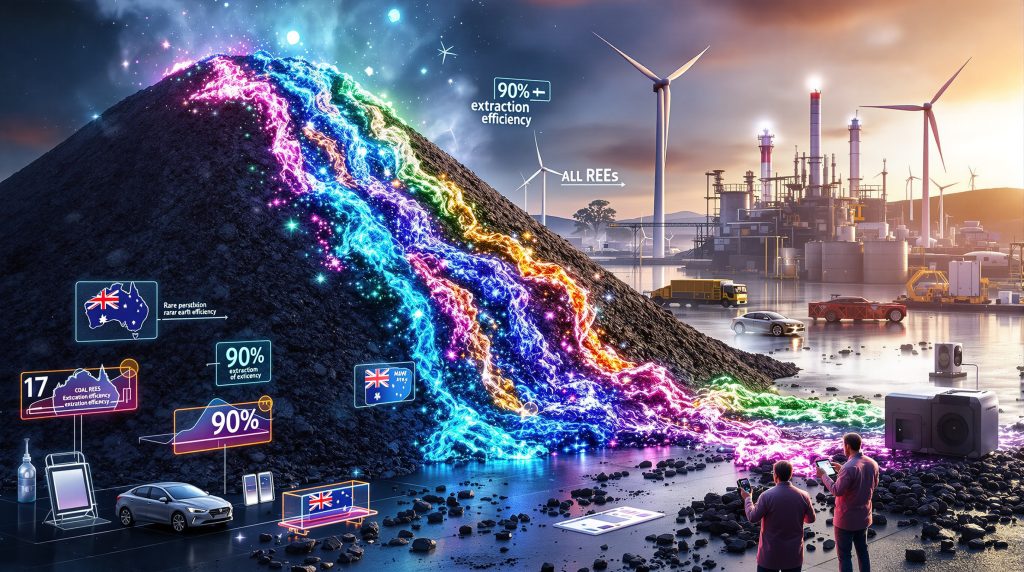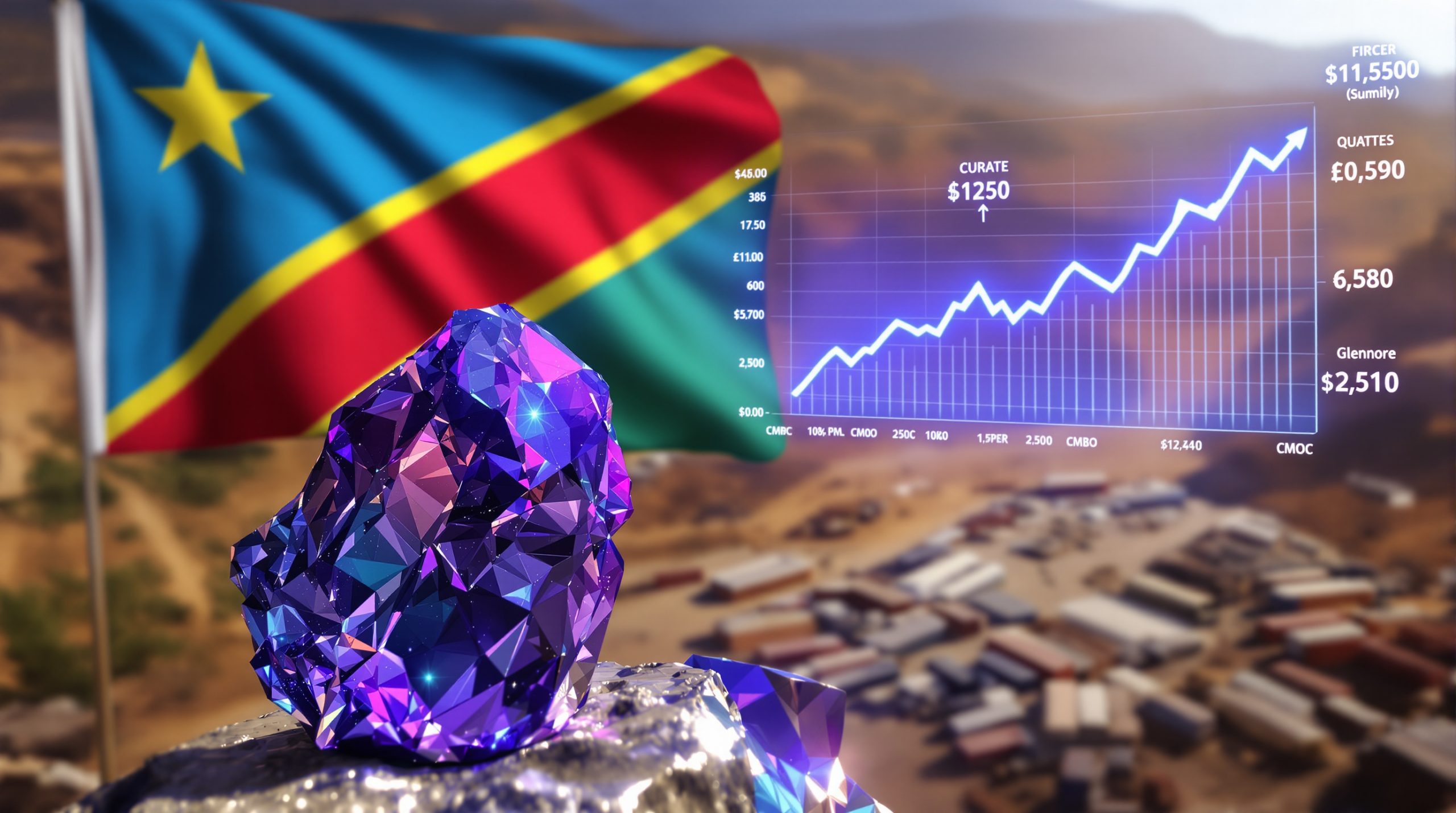What is Coal Ash and Why is it Valuable for Rare Earth Elements?
Coal ash, traditionally viewed as an industrial waste product, contains significant concentrations of rare earth elements (REEs) that represent an untapped resource stream. Australian coal-fired power stations generate more than one million tonnes of fly ash annually in Victoria alone, creating substantial stockpiles that could serve as ready-made sources of these critical materials.
Unlike traditional rare earth mines that require extensive development and often contain radioactive elements, coal ash from Victorian brown coal is notably free from these radioactive components that typically complicate conventional mining operations. This makes the extraction process potentially simpler and environmentally safer.
The presence of all 17 rare earth elements in coal ash, extractable with over 90% efficiency using innovative processing methods, positions this waste product as a strategic solution to critical minerals demand. These elements, essential for green technology manufacturing, could be sourced from materials previously considered environmental liabilities.
This paradigm shift in resource thinking creates opportunities to address both waste management challenges and critical mineral shortages simultaneously, potentially reducing dependence on traditional mining operations that have significant environmental footprints.
How Monash University's Breakthrough Technology Works
The Extraction Process Explained
Monash University researchers have developed a novel technique that can extract all 17 rare earth elements from coal fly ash with over 90% efficiency. The process works through a carefully orchestrated sequence:
- Collection of coal ash from power plant waste ponds where decades of material has accumulated
- Application of specialized chemical treatments that selectively separate REEs from other materials in the ash
- Processing of the extracted elements into forms suitable for manufacturing applications
This urban mining approach transforms what was once considered waste into valuable resources through innovative chemical engineering, bypassing many of the challenges associated with traditional mining.
From Laboratory to Industrial Scale
The technology has progressed rapidly through several development stages:
- Initial bench-top experiments proved the concept and established baseline efficiency metrics
- Scaled up to a 30-liter system for further testing and process optimization
- Currently building a 100-liter semi-continuous unit to evaluate industrial potential
- Plans underway for a demonstration plant on the Monash campus to showcase commercial viability
This scaling trajectory suggests the potential for commercial implementation within a shorter timeframe than traditional mining industry trends, which typically require 10-15 years of development before producing their first tonne of material.
The rapid progression from laboratory to pilot scale indicates strong confidence in the fundamental process, though challenges remain in maintaining extraction efficiency at larger scales and optimizing energy consumption in the extraction process.
What Makes Coal Ash a Superior REE Source?
Environmental Advantages Over Traditional Mining
Coal ash from Victorian brown coal offers distinct advantages as a rare earth source:
- Free from radioactive elements that complicate conventional rare earth mining and processing
- Utilizes existing waste material rather than requiring new land disturbance and habitat destruction
- Reduces the need for ash dam management and long-term mine reclamation innovation
- Minimizes the environmental footprint compared to traditional mining operations that require extensive land clearing
These environmental benefits address some of the most significant challenges associated with conventional rare earth mining, which often involves managing radioactive waste and extensive land disturbance.
Economic Benefits of Urban Mining
The economic case for this "mining without mining" approach includes several compelling advantages:
- Elimination of exploration risk and associated costs that traditional mining companies must bear
- Reduction of decade-long lead times typical for new mines, accelerating time to market
- Utilization of existing infrastructure and logistics networks, reducing capital requirements
- Consistent and well-characterized feedstock composition, improving process predictability
- Potential conversion of environmental liabilities into valuable assets, transforming cost centers into revenue streams
As Scott North, co-founder of Kamoa Capital, noted, "If this process really works at scale, you're talking about flipping a liability into an asset. Logistics are already in place, the feed source is consistent, and there's no exploration risk."
This approach effectively shortens the supply chain while potentially reducing overall production costs, though economic viability at industrial scale remains a key question that requires further demonstration.
How Much Rare Earth Material Could Coal Ash Provide?
Production Potential from Australian Resources
According to the Monash research team, Australian coal ash resources represent a significant untapped REE reserve with remarkable production potential:
| Potential Annual Recovery | Comparison to Current Production | EV Manufacturing Capacity |
|---|---|---|
| 45,000 tonnes of REEs | More than twice Australia's 2021 production (approx. 22,500 tonnes) | Enough for magnets in approximately 15 million electric vehicles |
| Nearly 30% of current global production |
This production potential is especially significant considering that traditional mining operations require extensive development periods and substantial capital investment before yielding any product. The coal ash approach could potentially accelerate REE availability while traditional mines are being developed.
The volume of available feedstock is substantial, with Australian coal-fired power stations generating more than one million tonnes of fly ash annually in Victoria alone. This consistent supply creates opportunities for long-term production planning without the uncertainty that often affects conventional mining operations.
Why Are Rare Earth Elements So Critical Now?
Strategic Importance in Modern Technology
Rare earth elements play essential roles in numerous high-tech and green energy applications that are central to the global energy transition:
- Permanent magnets for electric vehicle motors and wind turbines, enabling efficient energy conversion
- Catalysts for petroleum refining and emissions control systems that reduce environmental impacts
- Phosphors for energy-efficient lighting and high-resolution displays
- Components in defense systems and communications technology critical for national security
- Critical materials for medical imaging equipment and other healthcare technologies
The increasing adoption of electric vehicles, renewable energy systems, and advanced electronics has accelerated demand for these materials, creating potential supply bottlenecks as production struggles to keep pace with growing consumption.
The China Supply Challenge
The global rare earth market faces significant supply constraints that create strategic vulnerabilities:
- China currently controls approximately 90% of global REE refining capacity
- Recent export quota restrictions from Beijing have tightened supply to international markets
- Growing domestic Chinese demand further limits international availability as China's own manufacturing sectors expand
- Geopolitical tensions increase supply vulnerability for Western nations dependent on these materials
- Historical price volatility creates uncertainty for downstream manufacturers planning production
These supply challenges have prompted countries including Australia and the United States to seek alternative sources and processing methods to reduce dependence on Chinese supply chains. The coal ash extraction approach represents one potential pathway to diversify supply sources and increase resilience against market disruptions.
How Does This Fit Into Australia's Critical Minerals Strategy?
Positioning in the Global Supply Chain
Australia has established itself as a trusted partner in critical minerals supply, with several strategic advantages:
- Existing rare earth operations like Lynas in Western Australia provide production experience and expertise
- Development of new processing capacity such as Iluka's Eneabba refinery demonstrates ongoing investment
- Potential for price floor mechanisms similar to US arrangements that provide market stability
- Strong regulatory framework and environmental standards that meet international expectations
- Stable political environment attractive to international partners seeking supply security
These factors position Australia favorably in the increasingly competitive critical minerals landscape, where geopolitical considerations are becoming as important as economic ones in supply chain decisions.
Complementing Traditional Mining
The Monash coal ash extraction technology would complement rather than replace traditional mining:
- Provides near-term supply while new mines are developed through conventional means
- Diversifies the supply base to reduce market volatility and price fluctuations
- Creates additional processing expertise and infrastructure that benefits the broader sector
- Supports circular economy principles through waste utilization, enhancing Australia's sustainability credentials
This complementary approach recognizes that multiple supply pathways will be necessary to meet growing global demand for rare earth elements, with each approach offering different advantages in terms of timeline, environmental impact, and production costs.
What Policy Shifts Are Supporting This Innovation?
International Policy Alignment
Government policies in multiple countries are increasingly supporting alternative REE sourcing:
- US Geological Survey's critical minerals list prioritizes rare earths as strategically important materials
- Bipartisan US legislation introduced by Senators Mike Lee and Mark Kelly aims to accelerate domestic processing capacity
- US Interior Department focusing on recovery of minerals from mine waste, aligning with urban mining concepts
- Similar "urban mining" concepts gaining traction in policy circles globally as circular economy principles advance
- Growing recognition of circular resource strategies as supply chain solutions that address both economic and environmental goals
These policy shifts create a more favorable environment for innovative resource extraction like coal ash extraction, potentially accelerating commercialization through regulatory support, research funding, and market development initiatives.
The Trump administration's review of the US Geological Survey's list of critical minerals further emphasizes the strategic importance being placed on rare earth elements and related materials, creating additional policy momentum for alternative sourcing approaches.
What Challenges Must Be Overcome?
Economic Viability Questions
Despite its promise, the coal ash extraction approach faces several hurdles:
- Production costs must compete with conventional mining operations in a price-sensitive market
- Capital requirements for industrial-scale facilities remain significant, requiring substantial investment
- Market price volatility affects return on investment calculations and creates financing challenges
- Chinese market dominance creates competitive pressures that may impact pricing strategies
- Process optimization needed for commercial implementation to maximize efficiency and minimize costs
As Scott North from Kamoa Capital questioned, a key challenge remains whether the process can be done "cheap enough to compete with conventional supply, especially with China still controlling the bulk of the REE market."
Technical and Scaling Considerations
Moving from laboratory to commercial scale presents additional challenges:
- Maintaining extraction efficiency at larger scales as process dynamics change
- Managing variability in feedstock composition between different ash sources
- Addressing potential contaminants in the waste stream that may affect product quality
- Optimizing energy consumption in the extraction process to improve sustainability
- Developing appropriate waste management protocols for residual materials
Overcoming these technical challenges requires continued research and development, pilot-scale testing, and systematic process optimization to ensure that the promising laboratory results can be replicated at industrial scale with acceptable economics.
How Might This Transform Resource Management Thinking?
Circular Economy Implications
The coal ash extraction approach represents a shift in resource management philosophy with far-reaching implications:
- Reframing waste materials as valuable resource stockpiles rather than liabilities
- Reducing environmental liabilities while creating economic value from existing materials
- Shortening supply chains through local resource utilization, improving resilience
- Decreasing reliance on environmentally intensive primary extraction processes
- Creating models for other waste-to-resource conversion opportunities in different sectors
According to the Monash research team, the approach represents "an opportunity to reshape how Australia thinks about resources" by treating stockpiles as resources rather than waste, making immediate use of existing materials while avoiding the environmental footprint of new mining.
This philosophical shift extends beyond rare earth elements to suggest new ways of thinking about natural capital in mining across multiple sectors, potentially catalyzing similar innovations in other industries facing both waste management challenges and resource constraints.
What's Next for Coal Ash to REE Technology?
Future Development Pathways
The path from current research to commercial implementation includes several critical milestones:
- Completion of the demonstration plant at Monash University to validate process economics
- Industry partnerships for larger-scale implementation to share investment and risk
- Integration with existing waste management systems to optimize logistics and handling
- Development of specialized processing facilities optimized for different ash compositions
- Potential application to other waste streams like e-waste and mine tailings to expand resource recovery
The technology could also find applications beyond coal ash, with researchers noting potential for extracting rare earths from other waste streams including electronic waste and mining tailings, further expanding the circular economy approach to critical minerals.
This expansion of the technology's application could create additional value streams while addressing multiple waste management challenges simultaneously, maximizing the return on the research and development investment.
FAQ: Coal Ash to Rare Earth Elements
What are rare earth elements and why are they important?
Rare earth elements are a group of 17 metals with unique properties that make them essential for many high-tech applications, including electric vehicles, wind turbines, and defense systems. Despite their name, they're not particularly rare in the Earth's crust, but economically viable concentrations are uncommon.
How does coal ash compare to traditional rare earth mines?
Coal ash typically contains lower concentrations of rare earths than dedicated mines, but offers advantages including absence of radioactive elements, utilization of existing waste, and shorter development timelines. The environmental footprint is also potentially smaller than opening new mines.
Could this technology help reduce China's dominance in the rare earth market?
While no single approach will completely shift global supply dynamics, coal ash extraction could contribute significantly to diversifying supply sources. Combined with other initiatives, it could help reduce dependency on Chinese processing and refining capacity.
What happens to the remaining coal ash after rare earth extraction?
After rare earth extraction, the remaining coal ash could potentially be used in construction materials like cement or further processed to recover other valuable materials. Research continues on maximizing the utilization of all components of the waste stream.
Further Exploration:
Readers interested in learning more about innovative approaches to critical minerals can also explore related educational content, such as Tech Bytes: Turning coal ash into rare earth treasure, which offers additional perspectives on this emerging technology.
Want to Profit from the Next Major Mineral Discovery?
Discovery Alert's proprietary Discovery IQ model delivers instant notifications when significant ASX mineral discoveries are announced, giving you a crucial market advantage. Explore why major discoveries can lead to substantial returns by visiting the dedicated discoveries page and begin your 30-day free trial today.




